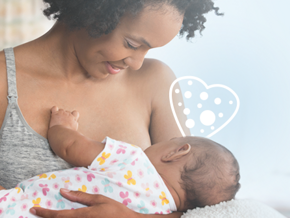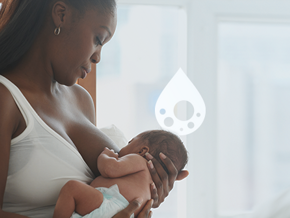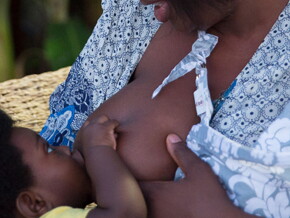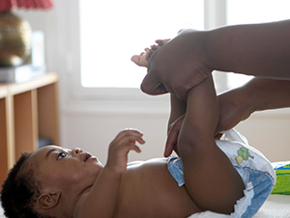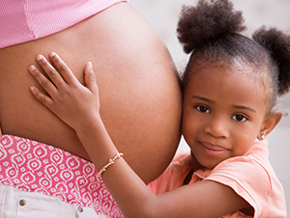
Breastfeeding problems?
Breastfeeding is well worth the practice and patience it can sometimes take. Here are some common concerns that breastfeeding mums have, and solutions to remedy them.
You should be aware of these 20 weeks pregnant symptoms and signs.
Sore nipples
It is common during early post-partum feedings to experience a slight discomfort when nursing that resolves within a minute of feeding. It can be caused by improper latch-on (from poor positioning), tight latch by your baby because of bottle and pacifier use, or when using a pump with a flange that doesn’t fit correctly. What can you do? Lots of things.
Basic remedies
- Practice skin-to-skin positioning between feedings. If your baby is crying between feedings and seems stressed, this will help her relax.
- Wait until your baby is calm and begins to look around. This will be a perfect time to help guide him to your breast.
- Experiment with different feeding positions such as the “cross-cradle” and “rugby” holds. Both provide a little more head and neck support, which may encourage a better latch.
- If baby's nose is pressed into your breast, lower her body slightly to help her nose come out and chin come into your breast for a better latch. Her head should not be overly tilted in or back.
- Feed baby from the least sore breast first to minimize an aggressive feeding on a sensitive nipple.
- Know how to get your baby off your breast - never pull him off before breaking the suction of the latch. Break his suction by placing your finger between your breast and his gums before taking him off your breast.
- Express a few drops of breast milk and rub on your areola and nipples after a feeding to help protect and soothe tender nipples. Allow your nipples to air dry after feeding as well.
- If you’re using a breast pump, see if it came with different flange sizes that will fit better. The lactation consultant at your local hospital or health department may be able to assess and find a properly fitted flange for you.
- Wear cotton clothing next to your breasts (a breastfeeding bra or a loose-fitting top).
- If your nipples are too sore to have your bra or clothing touch them, use breast shells with large nipple openings and holes for air circulation over your nipple and under your bra.
Breast engorgement
Hard and swollen breasts, usually in both breasts during early post-partum days, can be caused by infrequent or delayed feedings, over-production of milk, poor or inefficient milk removal, supplemental feedings, rapid or sudden weaning, or breast oedema.
Basic remedies
- Relieve the pressure in your breast as soon as possible by either breastfeeding, hand expressing your milk, or using a breast pump. If your breasts are too full for baby to latch on, express a little milk by hand or pump first.
- Breastfeed or pump every two hours to help build a good milk supply while relieving the engorgement. Remember, your newborn baby should be breastfed at least 8 to 12 times per 24 hours!
- Take a warm shower or place a warm, wet cloth on breasts.
- If your baby doesn’t breastfeed long enough to soften them, use a breast pump until both breasts feel comfortable.
- Use cold packs between feedings.
- If your hands and/or ankles are swollen due to retaining extra fluids, your breasts might also be swollen from retained fluids. Try pushing the excess fluid away from the nipple and areola. Place your fingers and thumb at the neck of your nipple and press into your chest for about a minute. The nipple should become more supple to allow breastfeeding or pumping to be more effective.
Tingling in your breasts
You may experience some tingling as your breasts adjust to breastfeeding.
Basic remedies
- If tingling only lasts a few seconds and occurs when your baby starts nursing, don’t worry, it's a normal sign of "let-down,” the release of milk from your breast.
Painful breasts
Feeling pain the first few days? Full but not swollen breasts during the early post-partum days can be caused by the transition from first milk to the surge of mature milk—about 2 to 5 days after birth. Call your physician if your breasts are painful, hot, have an area of spreading redness or you feel feverish (your temperature is over 38° C). You may have a breast infection and require medication.
Basic remedies
- Gently massage the upper part of your breasts.
- Apply a warm or cool relief pack.
- Take warm showers.
- Breastfeed frequently—at least 8 to 12 times per 24 hours.
- Make sure your baby is positioned correctly during each feeding. She should be lying with her whole body facing you.
- Check that your nipple and as much of the area around the nipple is covered almost completely with her mouth, her tongue on the underside of your areola. When removing her from your breast, remember to break the suction by gently sliding your finger in between your nipple and her gums.
Rapid milk ejection
Forceful spraying of your milk may result in your baby coughing, gagging and even pulling off the breast. Individual hormone response or overactive milk supply usually cause this.
Basic remedies
- Increase your baby’s control of the milk flow by adjusting his feeding positioning to an upright football hold, side-lying hold or a laid-back feeding position.
- Express some milk to catch the initial forceful flow before putting your baby to your breast may be helpful.
- Use a breast shield to allow for a slight barrier from the milk spray during the initial forceful “let-down” is another option. Proper use of the breast shield is very important and should be discussed with a lactation consultant as to not cause additional concerns due to improper use.
Chapped nipples
Breastfeeding may leave your nipples chapped and tender due to initial breastfeeding adjustments or from washing nipples with soap or using other drying agents such as alcohol.
Basic remedies
- Try a gentle moisturizing balm (a lanolin-free, hypoallergenic blend of natural emollients) to soothe chapped and tender breasts.
- Gently wash breasts and nipples with mild soap and water, and don't overuse soap or use rubbing alcohol, which can dry the skin and cause cracking.
- Apply some expressed breast milk on your nipples and allow them to air dry.
- Place a soothing gel patch inside your bra to prevent friction. The patches cool on contact.
Plugged milk ducts
A tender-to-the-touch lump anywhere on your breast or in your underarm area can be signs of a plugged milk duct. Several things may cause a milk duct to get plugged including inadequate feeding (emptying), scar tissue in the breast, underwire bras, tight-fitting bras, or tight-fitting sleeveless tops, feeding in the same position for all feedings or a plugged pore.
Basic remedies
- Apply dry or moist heat to the area by taking a hot shower or applying a warm wet cloth.
- Nurse or hand-express some milk while your breast is still warm.
- Offer the sore breast first, and encourage her to feed longer on that side.
- Massage the area during and between feedings.
- Alternate feeding positions.
- Avoid wearing a tight breastfeeding bra or one with underwire that may hold back milk flow.
- If the lump persists and becomes red and the redness spreads, you may develop a breast infection and fever, which will require immediate attention from your physician.
Slow-milk-ejection reflex
Milk “let-down” (release) from your breasts that takes longer than 10 minutes to occur may be due to feeling stressed or anxious about feedings or sitting in an uncomfortable feeding position or actually experiencing painful feedings.
Basic remedies
- Stay relaxed by singing or humming a song, reading a book, or calmly talking to your baby during feedings.
- Gently massage your breast with your hand before putting your baby to your breast.
- Breastfeed him in a calm, stress-free environment.
- Adjust to a more comfortable feeding position.
Leaking milk
Milk leaking from your breasts between feedings can be caused by it being close to feeding time or having a hormonal response to hearing a crying baby.
Basic remedies
- Use an absorbent breastfeeding pad or clean folded handkerchief inside your bra to catch the drip. Don’t forget to change it often. A clean pad prevents growth of bacteria, which thrive where it’s warm and moist!
- Place some direct pressure over the nipple of your breast to minimize the response.
Milk reduction
There are several reasons why milk supply may decrease that have nothing to do with your body’s ability to produce enough breast milk. Some common causes include:
- Formula supplementation.
- Return to work or school.
- Medications with decreasing milk production as a side effect.
- Significant increased, sudden stress.
- You may be a little dehydrated.
Basic remedies
- Add an extra feeding or pumping session to your daily routine.
- Practice skin-to-skin contact between feedings.
- Practice breast massage before and during feedings.
- Try to relax with your baby and get some rest.
- Take it easy and drink more fluids.
Over milk supply
If your breasts are very full and not “emptied” after full feedings, milk may spray after your baby comes off your breast satisfied, and your baby may seem uncomfortable after just a few minutes of feeding and come off your breast frequently. The most common reasons for over-supply are hormones, over-pumping, and your initial supply adjusting to your baby’s feeding needs during the first 4 to 6 weeks post-partum.
Basic remedies
- Increase your baby’s control of the milk flow by adjusting her feeding position to an upright football hold, side-lying hold or a laid-back feeding position.
- Feed from one breast per feeding session and pump the other breast only to provide comfort if it becomes uncomfortable between feedings. This may only be less than a minute of pumping.
- Continue to offer the same breast if baby is interested within two hours after his last feeding, then resume to the other breast for the next feeding.
Difficulty latching on
Your baby opens her mouth for your breast, but doesn’t latch on to feed. Common causes include using bottles or pacifiers, flat or inverted nipples or even an over-sleepy baby.
Basic Remedies
- Avoid pacifiers and bottle-feeding the first three to four weeks to firmly establish breastfeeding.
- Practice skin-to-skin as often as possible between feedings to help your baby get a nice deep sleep and be more rested and interested in the next feeding.
- Offer your breast during early hunger cues. Express some milk to have a few drops on your nipple before offering your breast.
- Express a small amount of milk from your breast by hand or with a breast pump before feeding to soften the areola and stimulate milk flow, so she will receive milk flow right away.
- Try different feeding positions.
- Consider a nipple shield for flat or inverted nipples if the nipple does not stay stimulated even after the use of a breast pump. Ask your lactation consultant about the proper use of a nipple shield. Improper use can result in additional concerns.
Learn more on breastfeeding guide, tips and much more!
